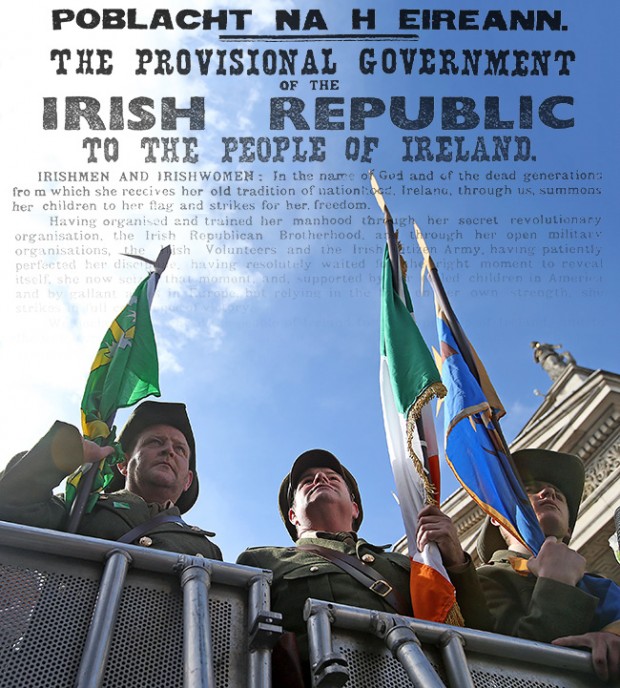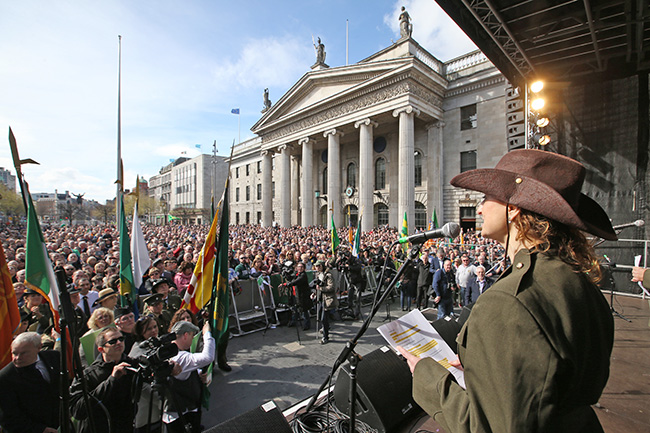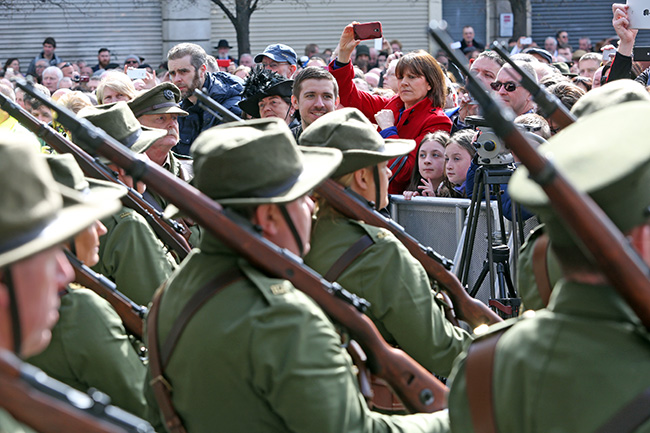16 May 2016 Edition
Proclaiming the Republic
Remembering the Past – Our history columnist Mícheál Mac Donncha reflects on the 1916 Centenary events

THE EXACT CENTENARY of the Proclamation of the Irish Republic was commemorated by Sinn Féin at the GPO on Sunday morning 24 April. The Proclamation was read from the platform several times that day but the first reading was in the Irish language by Aengus Ó Snodaigh TD, Cathaoirleach of Sinn Féin’s National Centenary Committee. Actor Ed Cosgrove played Pádraig Pearse, reading the Proclamation in English, and Martin McGuinness spoke. A short pageant linking the flags of Ireland with the 1916 leaders was narrated by Dublin MEP Lynn Boylan and by Dublin City Councillor Mícheál Mac Donncha, our history columnist, who scripted it. We carry here an edited version.
Fáilte, saoránaigh na Poblachta.
Céad bliain ó shin díreach ar an láthair seo fógraíodh Poblacht na hÉireann.
Welcome citizens of the Irish Republic of 1916 – the Republic of all 32 Counties.
Exactly 100 years ago, the Irish Republic was proclaimed on this spot.
This morning we remember the day.
We reaffirm the pledge of the Proclamation.
We honour the men and the women who defended the Republic.
The Green Flag of Ireland – Molly O’Reilly
On Sunday 16 April 1916, a young member of the Irish Women Workers’ Union, Molly O’Reilly, raised the green flag of Ireland over Liberty Hall. The ceremony was presided over by James Connolly, Commandant General of the Irish Citizen Army. Connolly said:
“On that day the Irish Citizen Army hoisted and unfurled the green flag of Ireland, emblazoned with the harp without the crown, as the sacred emblem of Ireland’s unconquered soul.”
The Tricolour – Tom Clarke
The Tricolour of green, white and orange was brought from revolutionary France by Young Irelander Thomas Francis Meaghar. It recalls Wolfe Tone, uniting all denominations of Irishmen and Irishwomen, and it was the republican flag of the Fenians. The spirit of Tone and Young Ireland and Fenianism were embodied in the first signatory of the Proclamation, Thomas Clarke, who said in his last message:
“I and my fellow signatories believe we have struck the first successful blow for freedom. The next blow, which we have no doubt Ireland will strike, will win through. In this belief we die happy.”
The flag of Fianna Éireann – Constance Markievicz
The youth of republican Ireland was organised in Na Fianna Éireann, co-founded in 1909 by Constance Markievicz. Their flag was the sunburst with its hope of a new dawn for Irish freedom. Shortly before the Rising, Markievicz, patron and leader of Fianna Éireann, wrote:
We are ready to fight for the Ireland we love
Be the chances great or small;
We are willing to die for the flag above
Be the chances nothing at all.
The flag of Cumann na mBan – Margaret Skinnider
Founded in 1914, Cumann na mBan organised the women of Ireland in the cause of freedom. Margaret Skinnider of Glasgow and Monaghan was one of the bravest. She wrote:
“For a long time after the Rising, I dreamed every night about it. The dream was not as it actually took place, for the outcome was always successful. My awakening was a bitter disappointment, yet the memory of our failure is a greater memory than many of us ever dared to hope.”

• Lynn Boylan MEP speaks to the huge crowd gathered outside the GPO on the 100th anniversary of the Rising
The flag of Ulster – Roger Casement
Reared in the Glens of Antrim, Roger Casement loved Ulster and all of Ireland. From the Glens he went to the Congo and the Amazon and always he upheld the banner of human rights and human freedom. On trial for his life in London, his words rang out across the world:
“Ireland is treated today among the nations of the world as if she were a convicted criminal . . . If it be treason to fight against such an unnatural fate as this, then I am proud to be a rebel, and shall cling to my ‘rebellion’ with the last drop of my blood.”
The flag of Connacht – Seán Mac Diarmada and Éamonn Ceannt
From County Leitrim came Seán Mac Diarmada; from County Galway came Éamonn Ceannt. Fired with Fenianism, both men worked night and day for Irish freedom. They lived the words of Thomas Davis’s song The West’s Awake:
But, hark! a voice like thunder spake,
The West’s awake! the West’s awake!
Sing, Oh! hurrah! let England quake,
We’ll watch till death for Erin’s sake.
The flag of Leinster – Joseph Plunkett
From an old Leinster family, a Dubliner, a poet and intellectual, a military strategist – Joseph Plunkett. His poem 1867, addressed to England, was both a tribute to the Fenians and a prophecy:
In the days of our doom and our dread
Ye were cruel and callous,
Grim death with our fighters ye fed
Through the jaws of the gallows;
But a blasting and blight was the fee
For which ye had bartered them,
And we smite with the sword that from ye
We had gained when ye martyred them!
The flag of Munster – Thomas MacDonagh
From County Tipperary, in the heart of Munster, Thomas MacDonagh was a teacher, a writer, a dramatist and poet. He worked in Scoil Éanna with Pádraig Pearse and commanded in Jacob’s Factory in Easter Week.
“I have been actuated by one motive only, the love of my country, the desire to make her a sovereign, independent state. I still hope and pray that my acts may have for consummation her lasting freedom and happiness.”
The Starry Plough – James Connolly
The Starry Plough was the flag of James Connolly’s Irish Citizen Army. In Easter Week it flew over the Imperial Hotel (now Clery’s) where in the 1913 Lockout the police had attacked the people on Bloody Sunday. Connolly asked:
“We are out for Ireland for the Irish. But who are the Irish? Not the rack-renting, slum-owning landlord; not the sweating, profit-grinding capitalist; not the sleek and oily lawyer; not the prostitute pressman – the hired liars of the enemy. Not these but the Irish working class, the only secure foundation on which a free nation can be reared.”

• The Cabra Historical Society
The flag of the Irish Republic – Pádraig Pearse
The banner of the Irish Republic was first flown here on this day a century ago. The President of the Provisional Government of the Republic was Pádraig Pearse. Ina dán ‘Mise Éire’ léirigh an Piarsach náire na hÉireann agus í faoi smacht ag an Bhreatain:
Mise Éire – sine mé ná an Chailleach Béarra.
Mór mo ghlóir - mé do rug Cú Chulainn cróga.
Mór mo náire – mo chlann féin do dhíol a máthair.
Mise Éire – uaigní mé ná an Chailleach Béarra.
But Pearse said that Easter Week wiped out the shame of slavery:
“We have lived to see an Irish Republic proclaimed. May we live to establish it firmly, and may our children and our children’s children enjoy the happiness and prosperity which freedom will bring.”
Thomas Ashe – The first of 22 hunger strike martyrs
The Republic was defended in arms, 16 leaders were executed, the struggle was renewed and Connolly’s words were fulfilled: “We shall rise again.”
Thomas Ashe had led the fight in Fingal. Múinteoir, cainteoir dúchais ó Chiarraí, Uachtarán Brathrachas na Poblachta i 1917. A teacher, native Irish speaker from Kerry, a piper and founder of the Black Raven Pipe Band, he was President of the Supreme Council of the Irish Republican Brotherhood. In 1917 he began a hunger strike against criminalisation and died from the effects of forced feeding in Mountjoy Jail. He was the first of the 22 Irish republicans to die on Hunger Strike and today, 35 years after the 1981 H-Blocks Hunger Strike, we remember them also.
Thomas Ashe:
“They have branded me a criminal. Even if I do die, I die in a good cause.”
Bobby Sands:
“I may die but the Republic of 1916 will never die. Onward to that Republic and the liberation of our people.”




